Final report for ENE16-144
Project Information
Cover crops are multi-functional tools that provide numerous ecosystem services and impact on-farm economics, crop productivity, and system resilience to climate change. While there is a long history of cover crop research and extension in the Northeastern US, information on cover crop selection and management to maximize the potential ecosystem services provided has been scattered across institutions and is too general to provide recommendations tailored to the unique combinations of production goals and constraints found in the Northeast. As a result, the majority of row crop and vegetable farmers in the Northeast have not used cover crops, and those who do use cover crops may not be reaping the maximum possible benefit.
We worked with seven vegetable and row-crop farmers and thirty service providers in nine Northeast states and plant hardiness zones 4 - 7 to develop, test, and launch a cover crop selection and management tool tailored to their specific needs: https://covercrop.tools/.
The coronavirus pandemic disrupted the final year of our project; service providers were unable to field test the cover crop selection tool with farmers, preventing verification of the performance target. However, we have successfully given trainings on the tool, reaching a minimum of 250 agricultural service providers. At one training during the Mid-Atlantic Crop Management School, 94% of participants (n = 185, including 86 certified crop advisors) indicated they would use the tool in their work and 84% demonstrated successful use of the tool that would generate recommendations for farmers. These results indicate that the training was successful and there is a high likelihood that the cover crop selection tool will be deployed with farmers. Furthermore, $1,540,000 in grants have been successfully awarded building on this project to continue the work of the Northeast Cover Crops Council.
The coronavirus pandemic disrupted the final year of our project, and service providers were unable to field test the cover crop selection tool with farmers, preventing verification of the performance target. Though, we have successfully given trainings on the tool, reaching a minimum of 250 agricultural service providers. At one training during the Mid-Atlantic Crop Management School, 86 certified crop advisors indicated that 94% of them would use the tool in their work and 84% demonstrated successful use of the tool that would produce recommendations for farmers. These results indicate that the training was successful and there is a high likelihood that the cover crop selection tool will be deployed with farmers. Furthermore, $1,540,000 in grants have been successfully awarded building off of this project to continue the work of the Northeast Cover Crop Council.
A total of 270 Northeastern agricultural service providers will learn how to use the NECCC cover crop decision tool. These project beneficiaries will use the tool to make cover crop selection and management recommendations for 3,000 farmers who plant 1.5 million acres of row and vegetable crops.
Cover crops are multi-functional tools that provide numerous ecosystem services and impact on-farm economics, crop productivity, and system resilience to climate change. While there is a long history of cover crop research and extension in the Northeastern US, information on cover crop selection and management to maximize the potential ecosystem services provided is scattered across institutions and is too general to provide recommendations tailored to the unique combinations of production goals and constraints found in the Northeast. As a result, the majority of row crop and vegetable farmers in the Northeast do not use cover crops, and those who do use cover crops may not be reaping the maximum possible benefit.
We targeted vegetable and row-crop farmers in the states of DE, MA, MD, ME, PA, NH, NJ, NY, and VT via agriculture service providers. In 2014, roughly 10 million acres of field and 220,000 acres of vegetable (fresh market plus processing) crops were planted in these states (USDA-NASS, 2015). Most of these acres were not planted to cover crops. In a NCR-SARE survey (2015) of farmers nation-wide, the second-most commonly cited barrier to cover crop adoption was “selecting the right cover crop species for my system” at 35.9%, while “time/labor required for planting” was the most-commonly cited reason at roughly 50% of respondents (n = 1,415). These concerns were echoed by farmers in a recent survey conducted by the University of Vermont (Heather Darby, pers. comm.). Abundant data on cover crops exist which could help farmers in the Northeast to overcome common barriers to adoption. Making these data easily accessible to farmers could reduce the barriers to adoption across the Northeast. Our project created resources necessary to help farmers tailor their cover crop selection and management. Prior to this project we surveyed agriculture service providers in these states (covering ~8 million total acres; n = 304); over half of the respondents reported “sometimes, most of the time, or always” having difficulty locating cover crop resources. The most commonly-cited type of information respondents had difficulty locating was “fitting cover crops into the rotation” (42%), while the use of cover crop mixtures and selection of cover crops for use in difficult environmental conditions tied for second-place (39% each). The top three topics which farmers ask ag-service providers included fitting cover crops into their rotation, use of cover crop mixtures, and variety selection. Twenty-five percent of respondents reported that it was “very difficult” or “difficult” to tailor cover crop recommendations to farmer needs; the majority of respondents (53%) selected “neutral” in response to this question. There is clearly a need for a comprehensive and integrated effort to promote and support cover crop use in the Northeast.
Our proposed solution was to form a Northeast Cover Crops Council (NECCC) and modify existing online decision support tools for use in the Northeast. The cover crop council supports and encourages cover crop use in the long-term through outreach activities including an annual conference, and by serving as a central clearinghouse for cover crop resources and tools in the Northeast. The annual conference allows researchers and agricultural professionals to define knowledge gaps, build networks, and coordinate necessary research to address these gaps. In the intermediate- and long-term, it is our on-going goal to use data synthesis and meta-analysis to modify several existing cover crop tools and calculators for use in the Northeast. These tools and calculators are associated with the NECCC website. For this proposal (i.e. in the short-term), we intended to modify the existing Midwest Cover Crops Council (MCCC) online cover crop decision tool for use in the Northeast. We determined that our solution will be effective because we will be conducting the types of events and providing/making more readily-available the types of resources that agriculture service providers indicated in our survey they were most likely to use. For example, workshops/training events (58% of respondents) were the second-most commonly cited cover crop resources frequently used by agriculture service providers (extension bulletins, at 60%, were the most-commonly cited resource used) (total survey n = 304).
Cooperators
- (Researcher)
- (Researcher)
Educational Approach
Recruitment: We recruited ag-service providers to assist in cover crop tool modification through our key individuals, each of whom provided potential participant names and affiliations. We then contacted potential participants, explained our project, and requested assistance. We did not expect to have difficulty recruiting assistance given that 26% of respondents (n=304) in our pre-proposal survey indicated a willingness to assist with such a task. Once the tool was online and ready for use, we began reaching out to ag-service providers to teach them how to use the tool at sessions during events such as the Mid-Atlantic Crop Management School. These events were typically advertised online, through listserv mass emails, and via commodity-based farmer organizations.
Delivery methods: The ag-service providers who assisted in modifying the tool for each USDA hardiness zone (which was translated into state for end-users) learned how to use the tool during the modification process, which occurred via bi-monthly teleconferences. Once the tool was ready for use and available online, other ag-service providers learned how to use the tool both passively (through PowerPoint presentations) and actively (when computers with internet connections were available). At the same time, they were introduced to the other resources available through the Northeast Cover Crops Council, such as its website. This site includes collated cover crop resources pages. We offered Certified Crop Advisor continuing education units at the annual NECCC conference to encourage ag-service provider and farmer interest in our activities.
Curriculum topics: During the tool modification process and once the tool was available online to the general public, ag-service providers began to gain an intimate understanding of how the tool was created, how it works, how it has been modified for farmers in each state, and how to use the tool. During the same presentations through which use of the decision tool is taught, ag-service providers were introduced to other cover crop resources provided by the Northeast Cover Crops Council such as its website, which serves as a central location for cover crop information and opportunities to learn about upcoming cover crop events and activities.
Beneficiary support: Detailed instructions for how to use the tool have been posted online along with the tool. Northeast Cover Crops Council key individuals and other cover crop experts have their contact information posted on the council website, so anyone with questions/concerns can readily find someone to contact.
Milestones
Organizational Milestone
At least one researcher/extension educator per involved state (DE, ME, MD, MA, NJ, NY, PA, NH, and VT) and representatives from USDA-ARS and -NRCS will meet for the first annual NECCC meeting (3/31/2016). This meeting will lay the foundation for the NECCC by defining the organizational structure and timeline.
3
11
3
23
March 31, 2016
Completed
April 01, 2017
NE SARE PDP Cumulative Milestone Accomplishment Table 2016
Mar. 2016 NECCC Meeting Agenda
Nov. 2016 NECCC Meeting Agenda
We decided to hold two meetings in 2016, one on March 31-April 1 (spring) in Baltimore/Beltsville, MD and one November 16-17 (fall) in Beltsville, MD.
The spring meeting served as an initial gathering of interested stakeholders to begin the process of building rapport. The agenda (attached) included time for stakeholders to discuss cover crop developments in their state and provide insight as to what the goals/expectations should be for the Northeast Cover Crops Council. Dean Baas from the Midwest Cover Crops Council spoke about that group’s formation and efforts, Michel Cavigelli presented an overview of the Northeast Climate Hub, and Brandon Smith introduced the group to the NRCS Soil Health Initiative. The cover crop decision tool was presented along with plans to modify it for use in the Northeast. The meeting was attended by one representative from the Midwest Cover Crops Council and one from the Southern Cover Crops Council, roughly six representatives from USDA ARS or NRCS, five ag-industry personnel, three farmers, and twelve university/Extension personnel.
At the fall meeting, we contracted with a meeting facilitator (Joseph McIntyre of Ag Innovations). Mr. McIntyre assisted us in creating a process-based agenda (attached) with small-group work/exercises that were so fruitful that we intend to write a publication based on meeting activities (Fig. 1). Agenda topics included the strategic contexts for the Northeast Cover Crops Council (external context, internal capacity, our definitions of success, organizational opportunities and weaknesses), mission statement development, discussion of our governing structure and leadership, discussion of the website and cover crop decision tool, and brainstorming of new ideas for research and funding. One representative from the Southern Cover Crops Council, seven ag-industry personnel, roughly ten farmers, seven USDA ARS or NRCS personnel, and twelve university/Extension personnel attended the meeting. Among attendees were at least one representative from a non-profit and one state agriculture department.
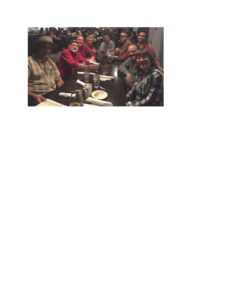
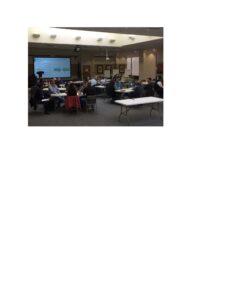
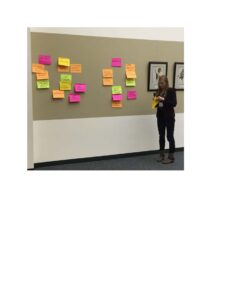
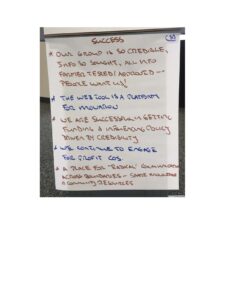
Figure 1. Activities at the November 16-17, 2016 Northeast Cover Crops Council meeting (clockwise from top left): stakeholders met for dinner nightly; small-group discussion; Kate Tully reports on conclusions reached by her group; whole-group discussion and flip-charts also featured on the agenda.
Hybrid Organizational and Tool Development Milestone (added/extra)
At least one researcher/extension educator per involved state (DE, ME, MD, MA, NJ, NY, PA, NH, and VT) and representatives from USDA-ARS and -NRCS will meet for the annual NECCC meeting (Nov. 7-9, 2017). The board meeting (Nov. 7) will continue to define the organizational structure and timeline. The Nov. 8 (educational sessions) and Nov. 9 (field day at Big Flats Plant Materials Center) part of the meeting will be open to the public and will serve as initial outreach for the NECCC. One of the educational sessions will focus on providing information about cover crop tools and soliciting feedback from the public. Numbers in drop down boxes below only quantify participation in the NECCC governing board session.
11
12
November 09, 2017
Completed
November 09, 2017
The first Northeast Cover Crops Council meeting open to the public was held Nov. 8-9, 2017 in conjunction with Cornell University (Ithaca, NY) and the NRCS Big Flats Plant Materials Center (Big Flats, NY); a (closed) governing board meeting was held Nov. 7, 2017. Fifteen people attended the board meeting in person or via teleconference; topics for discussion included the creation of a partnership between the NECCC and the Pennsylvania Association for Sustainable Agriculture, timing and structure of yearly meetings (both the governing board meeting and public sessions), governing board responsibilities and structure, and committee formation.
Over 160 registrants attended the Nov. 8 educational sessions (see attachment below), which were divided into three concurrent sessions. Attendees included a mix of farmers, ag-industry employees, and government agency employees; CCA CEUs were available. Approximately 40 attendees completed an event evaluation form; the response to the meeting was overwhelmingly positive. Nov. 9 featured a half-day field day at Big Flats Plant Materials Center, where attendees were able to view cover crop demonstration plots and field equipment.
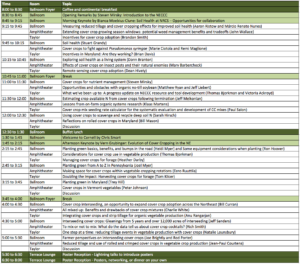
Milestones 3-13 were revised from original due to the change in process for tool development as described below.
Tool Development Milestone
170 individuals (service providers and farmers) receive an invitation to provide comments on the decision tools at the 2017 Northeast Cover Crops Council conference - the first open to the public.
100
90
120
November 30, 2017
Completed
November 15, 2019
The Northeast Cover Crops Council has now successfully held three conferences open to the public (Nov. 2017 - Ithaca, NY; Nov. 2018 - State College, PA; Nov. 2019 - Hyattsville, MD). Each of these conferences attracted 140-170 participants; farmers have comprised roughly 20% of attendees, with a further 50% consisting of ag consultants (e.g., extension, CCAs, NRCS personell) and the rest being researchers/primarily academics. Sessions on the tools and to gain tool feedback have been held at each conference.
Tool Development Milestone
The project development team will meet throughout the year to format the decision tool data into data dictionaries, which enable comparisons of data types within tools and retrieval of data in easily-reviewed chunks, and to assist with development of online tool prototypes. (Jan – Dec. 2018)
3
2
3
December 31, 2018
Completed
November 15, 2019
Since the inception of this grant proposal, the process for modifying the Midwest Cover Crops Council tool for use in the Northeast has changed. At each meeting (spring and fall 2016, fall 2017), there has been a presentation about the decision tool and a call for assistance. The cover crops council decision tool committee consists of nine volunteers (one from ARS, two from NRCS, four researchers/extension personnel from (one each from NY, PA, MD, and VT), one farmer, and the council program manager).
Input from this committee (and the general audience at each Northeast Cover Crops Council conference) has lead us to make the following changes. While the tool will still be state-based (e.g., a user indicates location by indicating state), the underlying data will be modified by hardiness zone rather than by state. Since there are fewer hardiness zones than states in the Northeast, this change reduces the burden on experts/farmers who are providing input (the small size of Northeastern states means one professional may have experience/responsibilities for multiple states). Rather than meeting in person then participating in multiple long conference calls to modify the tool, experts will individually review chunks of data within their area of expertise (e.g., a nematologist might review the data underlying a category addressing cover crop interactions with nematodes) and only when experts disagree will a data point be discussed to reconcile differences. Tool modification began with hardiness zone 6. The cover crop council program manager (i.e. Dr. Victoria Ackroyd) provides initial data in AirTable based on resources such as the Midwest Cover Crops Council tool and USDAPlants database. Tool modification (and the rest of the milestones) will then progress as previously described, barring the changes mentioned here. Progress has been slower than anticipated due to the development of a national team interested in greatly expanded tools (beyond the scope of this current grant); there has been a need to consider this effort in conjunction with other efforts. However, the changes noted above increase the efficiency of the tool modification process and we believe we will meet our targets in a timely fashion.
The individual USDA hardiness zone teams described above were headed up by a 10-person "Zone leader team", along with post-doc Victoria Ackroyd, tool architect Ankita Raturi, and programmers Juliet Norton and Rohit Bandooni. The purpose of this group was to set in place the structure needed to commence the data verification process. This zone leader team met regularly in 2018-2019, with Drs. Ackroyd, Raturi, Bandooni, and Norton meeting frequently in 2019 to implement the suggestions and advice they provided. Data dictionaries were generated, data chunked, and prototypes/mockups designed as described.
Tool Development Milestone
Prior to the onset of the data verification process and concomitant with the initial development team work, a group of "zone team leaders" was identified and convened to ensure that the overall structures put in place matched the needs of Northeast ag service providers and farmers (e.g., agreeing on which cover crop usage goals should be included in the tool, such as "prevents soil erosion"; these goals form the basis for the recommendations provided by the tool and are based on the expert opinion provided by participants in each hardiness zone) (Jan 2017).
5
10
8
January 31, 2017
Completed
June 28, 2019
As of the summer of 2019, this milestone has been met. The "Zone team leaders" met regularly to discuss the progress of Drs. Ackroyd, Raturi, Norton, and Bandooni and provide input as to needed adjustments.
Tool Development Milestone
Five Extension educators/NRCS personnel, three agricultural industry representatives, and three farmers who work with cover crops in each hardiness zone (4-7) – 48 service providers and 18 farmers total - will participate in a rolling process to vet the decision tools, beginning with zone 6. Data in the tools will be broken into manageable “chunks” for review and once experts for the first zone have reviewed a chunk, that chunk will be sent to the experts in the next zone to be adapted for that zone. In this vetting process, the 11 experts from each hardiness zone will: 1) participate in a two-hour teleconference with the project team to discuss the cover crops in the tool for their zone and the characteristics to be listed or ranked for each cover crop; 2) review after the teleconferences one data chunk per week for their zone in Airtable; and 3) participate in three two-hour Zoom teleconference discussions with the project team, with calls spaced throughout the process. (June 2019)
18
48
7
30
June 30, 2019
Completed
December 30, 2020
We have completed the data verification process described in the milestone. We used a tool called AirTable instead of Google docs, but the same principle applied. There were approximately 10, 10, 14, and 8 members on zone teams 4, 5, 6, and 7 respectively. We started with zone 6 and finalized the last of the major zones, zone 4, in December 2020. The process has been slowed by participant availability and the need for more conference calls than expected because participants have generally preferred to talk through/interact with the data as a group. At the onset of the process each team was informed of the eventual need to keep records of outreach using the tool as described in the project proposal.
Tool Development Milestone
Six members of the hardiness zone vetting teams and five additional farmers will participate in 1-2 focus groups to discuss the design of the tool user interfaces. This knowledge, combined with the vetted data for each zone, will finalize the creation of the user interface for the decision tool. (June 2019)
5
6
10
20
June 30, 2019
Completed
February 14, 2020
The user interface has been created, based on prototypes and input from focus groups. The first focus group (24 participants) took place at a dedicated session during the Nov. 2019 Northeast Cover Crops Council conference; further input was solicited at the Pennsylvania Association for Sustainable Agriculture conference in Feb. 2020 (15 participants).
Milestones 8-13 are Train-the-Trainer Milestones
150 service providers and 50 farmers receive notice of the new tools available via the NECCC listserv; 20 respond to the invitation to beta-test online and provide feedback to the project team. (June-Dec 2019)
50
150
15
December 31, 2019
Completed
December 30, 2020
Tool developers requested a more focused testing protocol than originally proposed. We conducted one-on-one alpha testing with four participants to refine our questions and protocol. We then conducted beta-testing using this protocol with a further 11 participants; this phase of testing concluded with two focus group teleconference calls to clarify initial feedback and gather further information. During this process participants learned about the tool and how to use it, in turn identifying features in the tool that needed to be addressed immediately or refined in future versions of the tool.
30 service providers will participate in a train-the trainer webinar, with recording available for later viewing by others. (Sep 2019)
30
100
September 30, 2019
Completed
November 21, 2019
The tool was presented at a session of the Mid-Atlantic Crop Management School (Ocean City, MD).
30 service providers and 10 farmers will attend a hands-on training session on how to use the new decisions tools at the 2019 NECCCC Conference, which will have “New Cover Crop Tools for the Northeast” as its theme. (Nov 2019)
10
30
20
November 30, 2019
Completed
November 07, 2019
A session titled "CC Tools + Resources" was held at the 2019 Northeast Cover Crops Council annual conference in College Park, MD. Participants were presented with case studies (i.e. scenarios outlining information for a cropping system and goals for the cover crop(s) to be chosen), then asked to work in small groups using the tool to generate recommendations.
30 total service providers participate in one of 3-4 hands-on train-the-trainer workshops conducted across the region to beta-test the tools and gain practice using them in farm-advising situations. (Nov. 2019 – February 2020)
30
205
February 29, 2020
Completed
November 16, 2020
We provided training and solicited feedback on the tool at three events: the annual Pennsylvania Assoc. for Sustainable Ag. conference (Feb. 5, 2020; Lancaster, PA; ~ 10 participants), the 2nd DelMarVa Soil Summit (Feb. 26, 2020; Georgetown, DE; ~10 participants), and the Mid-Atlantic Crop Management School (Nov. 16, 2020; virtual; ~185 participants).
270 service providers, including service providers who helped with tool development, those who attended train-the-trainer workshop sessions at NECCC and other venues, and the webinar training respond to requests for verification data (submission of recording worksheets and survey questions) 3-6 months after trainings, to report on their teaching/advising activities conducted with farmers. (Jan - August 2020)
270
August 31, 2020
Incomplete
Corona-virus related restrictions and interruptions beginning in late Feb. 2020 greatly disrupted work. Data verification for the northernmost hardiness zones was slowed due decreased availability of experts to participate in the process (e.g., childcare responsibilities were cited several times as the reason previously-involved participants could no longer do so). As a result data verification (and thus roll out of the tool for all states) was not completed until the end of 2020. The pandemic also disrupted the end of the 2019-2020 winter extension season and upended summer workshops/field days, decreasing opportunities for further training on the tool and for ag-service providers to use the tool with farmers. Ag-service providers who attended our sessions including the Northeast Cover Crops Council and PASA conferences, the DelMarVa Soil Summit, and Mid-Atlantic Crop Management School, were advised of NE SARE's role in funding the project and our need for feedback and data verification.
15 farmers who participated in tool development and/or training workshops respond to verification requests and report on their use of the decision tool. (Aug 2020)
15
20
August 31, 2020
Incomplete
This milestone was not completed due to our inability to complete the previous milestone.
Milestone Activities and Participation Summary
Educational activities and events conducted by the project team:
Participants in the project’s educational activities:
Learning Outcomes
The online Nov. 2020 Mid-Atlantic Crop Management School at which we presented a train-the-trainer session required participants to take a quiz to receive continuing education credits and allowed us to verify knowledge/etc. in a unique way. We provided organizers with a few questions to test participant understanding of the materials we provided. Organizers also asked participants for basic demographic info (e.g., "Are you a CCA?") and about session effectiveness (e.g., Please indicate the extent to which you (dis)agree: I learned something new...).
Eighty six people who took the quiz indicated they are CCAs (total n=185). The majority of participants were from DE and MD, followed by WV, VA, PA, NJ, MO, and NC. About 97% of respondents (n=172/178) indicated they learned something new from the training while 94% (n=166/167) agreed they would use the information presented. For a question asking participants to identify the information sources underlying the tool, 68% of respondents identified the correct answer. In addition, 84% correctly answered a question that required understanding the meaning of a feature on the user interface and 92% correctly answered a question that required users to understand tool output. These results suggest that the training was generally successful.
Performance Target Outcomes
Performance Target Outcomes - Service Providers
Target #1
270
A total of 270 Northeastern agricultural service providers will learn how to use the NECCC cover crop decision tool. These project beneficiaries will use the tools to make cover crop selection and management recommendations for 3,000 farmers who plant 1.5 million acres of row and vegetable crops.
3000
1.5 million acres
Attendees at all events mentioning this project/the tool were advised that NE SARE was funding the work. Any in-depth overview of the tool included notice that verification was a key component of the project. At the one formal train-the-trainer event that took place with the final released version of the tool (the Mid-Atlantic Crop Management School in Nov. 2020), participants were asked to send feedback if they used the tool with farmers. Since this cohort of service providers have only just received training, there has been no feedback thus far. This is likely due to both the pandemic greatly decreasing service providers contact with growers and the limited amount of time service providers have been engaging growers with this tool.
Additional Project Outcomes
Overall our data verification method was effective, though few participants wanted to do “homework”. Rather, most changes to the underlying data in the tool were done actively during teleconferences. Because we went hardiness zone by zone, we did take care to loop back around to other zones when one zone raised a unique question or offered a distinctive approach to a data point. As a result, this was a very holistic process in which the end product (i.e. the NECCC tool) came to very clearly represent the Northeast region rather than simply being a repackaging of the Midwest tool. For example, our data verifiers felt the need to split the goal “Decreases soil erosion” into “Decreases fall soil erosion” and “Decreases spring soil erosion”, which allows users to hone in on their specific concerns and needs.
We found the coronavirus epidemic to be very challenging and it greatly slowed our progress. Data verification, which we expected to take 4-6 months, took over a year. The experts who generously lent their time and expertise were struggling to adapt to conditions caused by the pandemic (e.g., lack of childcare), which prolonged the process due to cancelled meetings and similarly slow progress. Likewise, the typical train-the-trainer events and workshops were cancelled or moved online, hampering our ability to conduct beta-testing and training events. We have learned how to function in a time of online events, and can draw on that experience in the future. Work to fine-tune the tool’s programming is ongoing, as is the development/refinement of related tools such as a seeding rate calculator.